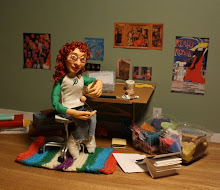

Haroun & the Sea of Stories
Luka & the Fire of Life
[Random House, September 16th, 2010]
by Salman Rushdie
Have you ever had a child ask you why? The ubiquitous why, followed by your fumbling to come up with an answer that, if it is buried in your mind, is too complicated to explain? Rushdie gives you an answer: the P2C2E (problem, or process, too difficult to explain) perfect to use in the rush of life, when most of the objects around you are too complicated for you to understand, let alone explain.
If you’re an adult and have browsed the Rushdie selection at your local bookseller or library you may have seen Haroun and the Sea of Stories, though my experience tells me the odds are not that good. What you most definitely have not seen is a Rushdie in the children’s section and I think we ought to change that.
Haroun and the Sea of Stories is loved by both children and adults. It is very much a nonsense adventure, reminiscent of The Phantom Tollbooth and full of Carroll-esque wordplay. P2C2Es, iffing and butting, glumfish, these words beg to be read aloud, told over nights to intent yet gigging children, and yet no audio version is available, meaning the story must be personally experienced in the act of reading aloud. Containing such marvels as the Ocean of the Streams of Story, Wishwater presented by a genie, and a city in Perpetual Night, Haroun is a marvelous story full of beautiful embroideries. But Haroun is also an allegory, and adults familiar with Rushdie’s personal story will see aspects of his life played out by the Shah of Blah.
Luka and the Fire of Life, written for Rushdie’s second child, is an adventure for the Shah of Blah’s second child. Again, we follow a classic journey into lands of the unknown and through a series of trials our protagonist comes of age. Like Haroun, Luka is aided throughout the book by an afflicted version of his father, in this case his father’s death, Nobodaddy. But unlike Haroun, this book resonates more strongly for children than adults, having references to current culture and following the form of a video game.
The World of Magic is a world of Luka’s father, Rashid Khalifa’s, creation. It is the stories he has told that populate this world, from characters of Egyptian mythology to Doctor Who. As such, Luka recognizes aspects of it and is able to navigate it based on his interactions with his father. But no child knows all the secrets of his parents and Luka faces the unknown as well (otherwise it wouldn’t be an adventure).
At the same time, this is very much Luka’s adventure. A child of the twenty-first century, video games are a part of Luka’s life. His adventure takes the form of a video game with literal levels for each stage of the hero’s journey. Lives can be accumulated and are tracked in a counter at the edge of Luka’s vision. Additionally, there are saving points at the ends of levels, and, like a video game, saving allows one to return to the same point upon obliteration. While this format may be awkward for some adults, I think it will resonate with middle grade readers, for whom such a structure is commonplace.
Yet the old myths and stories are utilized by Rushdie as well. The one strong female character in the World of Magic is a young woman named Soraya, the same name as Rashid’s wife and Luka’s mother. Being the most important woman in the lives of both Rashid and Luka, she naturally is the woman in Rashid’s world. In a classic nod to Oedipus, Luka is not only in awe of this woman, but slightly attracted to her as well. This nod to Greek tragedy may well pass over the heads of middle readers while jumping out at adults. It is this duality, this melding of both old and new tales, that allows Rushdie’s work to resonate with both adults and children. However, I wonder at the choice to publish this novel as an adult book.
Unlike Haroun, which can be read on many levels, Luka and the Fire of Life doesn’t push as far. There is less word play, less struggle between good versus bad and the eventual discovery of grey, things that are associated with classic crossover stories. Luka’s initial curse, and the resulting counter-curse, are a classic way to begin a story and his companions, Dog the bear and Bear the dog, are the sort of things you know you’ve read before. But when Luka enters the World of Magic, his experiences, and the video-game format of them, feel more easily accessible to middle-grade readers than adults. This may also be attributed to the number of references thrown together in the World of Magic and the segmentation the levels bring to them; giving the book a slightly episodic feel that doesn’t follow as smooth an arc as Haroun.
Like many books primarily classified as middle-grade, Harry Potter and A Series of Unfortunate Events coming immediately to mind, Luka and the Fire of Life is also an enjoyable read for adults. But now that adults are getting more used to venturing into the children’s department for their novels, Luka and the Fire of Life may find a more comfortable home in the middle-grade section. After all, who can resist “the World of Magic” with “Elephant Birds, and Respecto-Rats, and a real, honest-to-goodness Flying Carpet, and then there was the little matter of becoming a Fire Thief” (ARC, pg 216).















